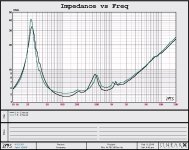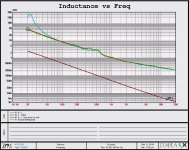Hello all,
I want to say thanks in advance for this resource. I lack the foundational knowledge so I will probably ask/say things that require clarification.
1. With a 2.5 way system where there are two 12" woofers in parallel, with a 20mH inductor in series with the second woofer, for calculating Zobel values, assuming if each woofer was 2mH each, would I say my total inductance was 1mh, ignoring the 20mh inductor?
2. Since there is not a published inductance for my woofer (that I could find for Altec 414z) is it ok to use the "standard" measurement at 1khz (like with a B&K 875B), considering my crossover point is 800hz and operating range much lower?
3. When measuring woofer inductance at 1khz or any other frequency, is it necessary to keep the cone stationary? I have read that the test should be done with the cone glued or in some kind of jig to keep it from moving.
Any help is appreciated!
Thank you.
I want to say thanks in advance for this resource. I lack the foundational knowledge so I will probably ask/say things that require clarification.
1. With a 2.5 way system where there are two 12" woofers in parallel, with a 20mH inductor in series with the second woofer, for calculating Zobel values, assuming if each woofer was 2mH each, would I say my total inductance was 1mh, ignoring the 20mh inductor?
2. Since there is not a published inductance for my woofer (that I could find for Altec 414z) is it ok to use the "standard" measurement at 1khz (like with a B&K 875B), considering my crossover point is 800hz and operating range much lower?
3. When measuring woofer inductance at 1khz or any other frequency, is it necessary to keep the cone stationary? I have read that the test should be done with the cone glued or in some kind of jig to keep it from moving.
Any help is appreciated!
Thank you.
1 You are correct about the parallel inductance being 1mh. When designing such things as Zobels or notch filters, the speaker parameters are used as well as the frequency band in which they are to be applied. Based on that, the 20mh inductor, which I assume to be part of the crossover, would not be considered in those calculations.
2 The published inductance for a loudspeaker is assumed to be taken at 1khz. However, when equalizing impedance such as with a Zobel, or a notch filter, neither methods I've seen directly use the voice coil inductance in their equations. This is already taken into account with the determination of the first two of the following parameters; Qes, Qms, Re and Fs, which are used. The determination of Qes and Qms is beyond the scope this text, so I strongly recommend Vance Dickason's book, "Loudspeaker Design Cookbook" available at parts Express for $34. The part number is 500-035. Mine is a 1991 edition which I use as a reference many times. Einstein once said, Oh heck, here's a link to that page. https://www.parts-express.com/loudspeaker-design-cookbook-7th-edition-book--500-035
3 A few decades ago, I read that while measuring the DC resistance of speaker voice coil that the cone should be "blocked". This was most likely due to vacuum tube meters which may have had a dc supply other than a battery to measure dc resistance. Such supplies would have some ripple which would adversely affect an accurate measurement of DC the resistance of the coil. When measuring a non reactive component, that ripple would have no effect. So, to answer your question about blocking the cone, that isn't necessary as long as no vibration is present. To see the effect of measuring DC resistance of a reactive component such as a voice coil in a magnetic field, cough at the cone at a distance of about a foot while observing the meter display.
Attached are two piccies of curves run on LMS of two ALTEC 415 bi-flex speakers I purchased in early '16. When I asaw them, I couldn't resist. The intent was to built a pair of A7's or VOTT's (Voice of the Theatre) but I'm still at odds as to where to place a pair of 22 cubic feet enclosures.
One shows the impedances of both units. The peaks between 200hz and 1200hz are most likely due to annulus resonances; these speakers are over 50 years old.
The other set of curves are those of voice coil inductance as a function of frequency. The light blue curve is that with the speaker in free air. The peak at the left is due to resonance The bottom curve is the inductance of the cable connecting the LMS to the speaker. The green and red curves are the inductances with the speaker face down on a sheet of MDF to simulate a blocked cone(red) and that curve minus the cable inductance(green), respectively. The difference between them is of no consequence other than being academic.
For a little more on these venerable acquisitions, here's a link to a page in my website. https://www.ln271828.net/ALTEC415CBiFlex.html
FYI. If you're interested or in need of replacement annuli for the Altac, here's another link. These annuli are a perfect fit for Altc 15" speakers. They are corrugated cloth, trade name is/was "Flexair".
Altec Lansing 15" Speaker Cloth Edge Repair Replacement Kit, CLSK-ALTEC15
Robert
2 The published inductance for a loudspeaker is assumed to be taken at 1khz. However, when equalizing impedance such as with a Zobel, or a notch filter, neither methods I've seen directly use the voice coil inductance in their equations. This is already taken into account with the determination of the first two of the following parameters; Qes, Qms, Re and Fs, which are used. The determination of Qes and Qms is beyond the scope this text, so I strongly recommend Vance Dickason's book, "Loudspeaker Design Cookbook" available at parts Express for $34. The part number is 500-035. Mine is a 1991 edition which I use as a reference many times. Einstein once said, Oh heck, here's a link to that page. https://www.parts-express.com/loudspeaker-design-cookbook-7th-edition-book--500-035
3 A few decades ago, I read that while measuring the DC resistance of speaker voice coil that the cone should be "blocked". This was most likely due to vacuum tube meters which may have had a dc supply other than a battery to measure dc resistance. Such supplies would have some ripple which would adversely affect an accurate measurement of DC the resistance of the coil. When measuring a non reactive component, that ripple would have no effect. So, to answer your question about blocking the cone, that isn't necessary as long as no vibration is present. To see the effect of measuring DC resistance of a reactive component such as a voice coil in a magnetic field, cough at the cone at a distance of about a foot while observing the meter display.
Attached are two piccies of curves run on LMS of two ALTEC 415 bi-flex speakers I purchased in early '16. When I asaw them, I couldn't resist. The intent was to built a pair of A7's or VOTT's (Voice of the Theatre) but I'm still at odds as to where to place a pair of 22 cubic feet enclosures.
One shows the impedances of both units. The peaks between 200hz and 1200hz are most likely due to annulus resonances; these speakers are over 50 years old.
The other set of curves are those of voice coil inductance as a function of frequency. The light blue curve is that with the speaker in free air. The peak at the left is due to resonance The bottom curve is the inductance of the cable connecting the LMS to the speaker. The green and red curves are the inductances with the speaker face down on a sheet of MDF to simulate a blocked cone(red) and that curve minus the cable inductance(green), respectively. The difference between them is of no consequence other than being academic.
For a little more on these venerable acquisitions, here's a link to a page in my website. https://www.ln271828.net/ALTEC415CBiFlex.html
FYI. If you're interested or in need of replacement annuli for the Altac, here's another link. These annuli are a perfect fit for Altc 15" speakers. They are corrugated cloth, trade name is/was "Flexair".
Altec Lansing 15" Speaker Cloth Edge Repair Replacement Kit, CLSK-ALTEC15
Robert
Attachments
Last edited:
Correction on the last link. Remove the # sign at the end. It should be Altec Lansing 15" Speaker Cloth Edge Repair Replacement Kit, CLSK-ALTEC15
In the sentence beginning with "Einstein once said", it should follow "why cram my head with a lot of information I can readily find in a book."
Robert
In the sentence beginning with "Einstein once said", it should follow "why cram my head with a lot of information I can readily find in a book."
Robert
Last edited:
- Status
- Not open for further replies.

